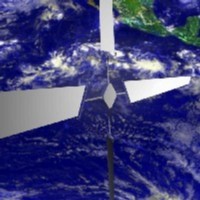Solar sail concepts have existed for decades, but their implementation has been elusive; to date, no true solar sail craft have flown in space. The primary difficulty with solar sails has been the need for great sail surface area relative to the payload mass. Also, the cost associated with manufacturing very large sails and the risks of deploying such structures in space has hindered their development. For example early solar sail spacecraft designs with payloads weighing hundreds of kilograms in mass led to sails with dimensions of kilometers.
Carnegie Mellon University will employ nanosat technology to dramatically reduce spacecraft payload mass, which shrinks the size of the sail and overall spacecraft mass. This reduction of size and weight makes a heliogyro type sail design eminently more practical and flyable than previous solar sail spacecraft.
The promise of solar sailing in space is in the continuous propulsion derived from natural solar pressure. The absence of a conventional propulsion system aboard the spacecraft means a smaller spacecraft can carry larger payloads. Another advantage is that solar sailing makes possible exotic missions once thought impractical due to their large propellant requirements. Such missions include dwelling at Lagrange points, hovering over an Earth pole and cruising to asteroids.


